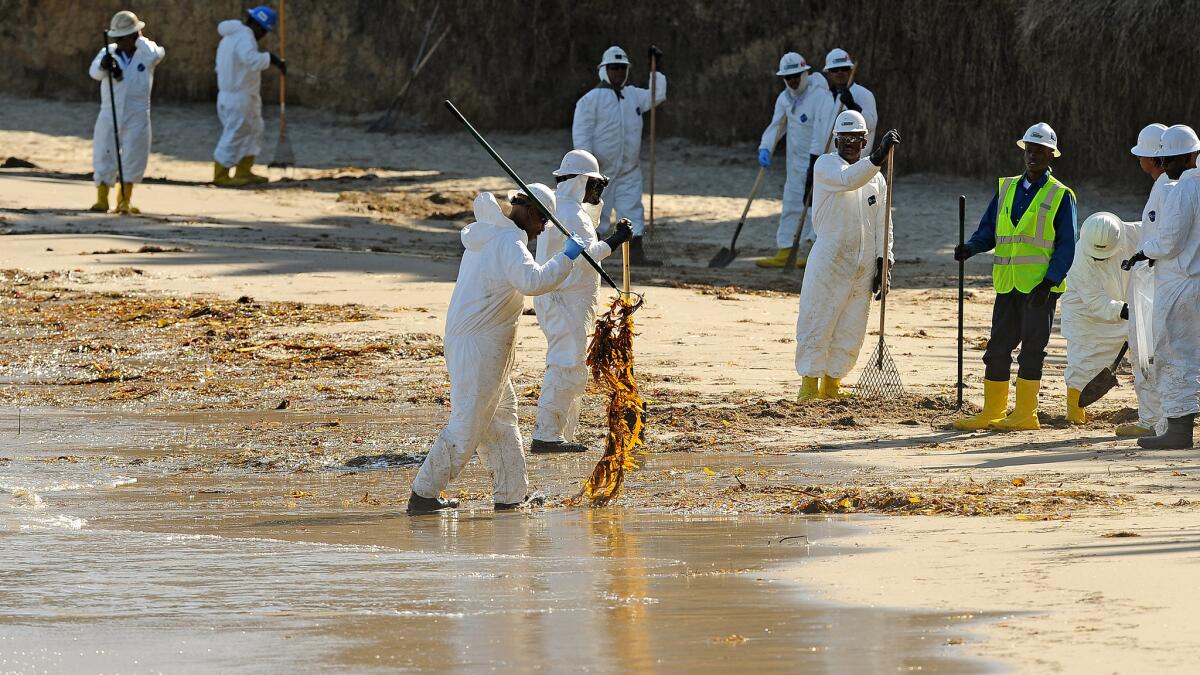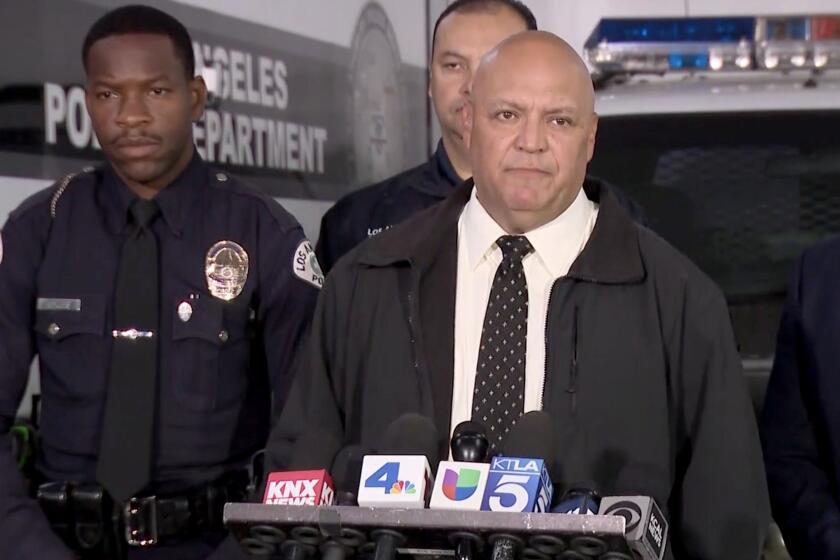Ruptured oil pipeline was corroded, federal regulators say

Oil spill cleanup at Refugio State Beach.
Corrosion had eaten away nearly half of the metal wall of a pipeline that ruptured and spilled up to 101,000 gallons of crude oil along the Santa Barbara coast last month, federal regulators said Wednesday.
The preliminary findings released by the federal Pipeline and Hazardous Materials Safety Administration provide the first details about the integrity of the ruptured pipeline but do not point to a cause for the failure.
Regulators said an inspection by third-party metallurgists revealed metal loss of greater than 45% of the pipe wall’s thickness in the area of the break.
That level of corrosion alone does not explain why the pipe failed, said Richard B. Kuprewicz, a pipeline incident investigator with 40 years’ experience who is not involved in this investigation. He said external corrosion is common and can be managed by adhering to a rigorous inspection and monitoring program.
“A 45% loss is not in itself a problem,” he said. “But a prudent operator has to stay ahead of this kind of thing. It’s called pipeline integrity management.”
The 10.6-mile pipeline had “extensive” external corrosion, and the thickness of the pipe’s wall where it broke had degraded to an estimated one-sixteenth of an inch, the pipeline agency said.
Investigators found a 6-inch opening along the bottom of the pipe where it broke on May 19. About 21,000 gallons of crude oil spilled down a culvert and into the Pacific Ocean near Refugio State Beach.
The area where the pipe broke had been repaired at least three times since the most recent comprehensive internal inspection, in July 2012, according to the regulators’ findings. Though the section that failed had lost nearly half of the wall’s thickness, other sections of the pipe had experienced more extensive losses.
Inspectors found external corrosion and metal loss ranging between 54% and 74% of the wall’s original thickness at three other spots, regulators said.
“These troubling findings suggest this pipeline was an accident waiting to happen,” said Miyoko Sakashita, oceans program director for the Center for Biological Diversity.
Plains All-American Pipeline, which owns the pipeline, conducted an internal inspection of Line 901 two weeks before the rupture but did not get preliminary results back until days after the spill.
It found that the wall of the pipeline was thicker than what the outside metallurgists found, but it was not clear by how much. Plains said it was working with regulators to understand the differences in their findings and pinpoint a cause of the rupture.
The failed pipeline transports crude oil from ExxonMobil’s storage tanks at its Las Flores Canyon facility to a pump station in Gaviota and operates at up to 120 degrees Fahrenheit.
Kuprewicz, the inspector, said he was not surprised the line was corroded, given that the pipe operates at a high temperature and had a history of repairs.
“Heated pipe is a bona fide risk threat. Every operator knows that,” he said. “It’s a heated line with a history of past concerns — no surprise. It’s going to be an expensive fix.”
The findings were posted online as part of a larger corrective action order sent to Plains All-American Pipeline. It gives the company 60 days to inspect another pipeline with similar corrosion issues — Line 903 — that transports crude oil 128 miles from Santa Barbara County to Kern County.
Line 903 is connected to the failed pipeline and has shown numerous signs of corrosion during three internal inspections in 2013 and 2014. The federal order called the corrosion data from the previous inspections “inconsistent” and called for a new review.
Plains spokeswoman Meredith Matthews said Wednesday the company would abide by the federal order. The order does not require Line 903 to stop operating, but Plains shut it down May 30.
Rep. Lois Capps (D-Santa Barbara) sent a letter Wednesday to the chairman of the House Energy and Commerce Committee requesting an oversight hearing in Santa Barbara to examine the cause of the spill and the response.
Since the spill, 12,167 gallons of oily water has been recovered from the Pacific. Workers have removed more than 5,000 cubic yards of oil-contaminated soil, sand and vegetation.
Response officials said 87 birds and 53 marine mammals have died. An additional 58 live birds and 40 marine mammals have been rescued.
Twitter: @jpanzar
Twitter: @julie_cart
More to Read
Start your day right
Sign up for Essential California for news, features and recommendations from the L.A. Times and beyond in your inbox six days a week.
You may occasionally receive promotional content from the Los Angeles Times.








